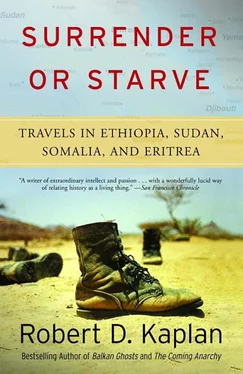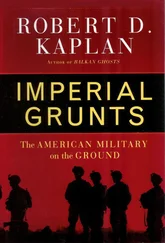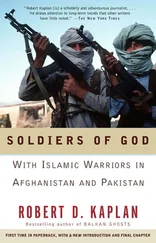The first great Ethiopian empire—the Roman-era kingdom of Axum—was centered in neighboring Tigre, thus making Eritrea practically a home province. Axum’s maritime trade was conducted through the ancient Eritrean port of Adulis, near modern-day Massawa. Internal dissension, the migration of Beja nomads from Sudan, and the rise of Islam eventually led to the kingdom’s demise in the ninth century a.d. From the tenth century onward, according to Colin Legum in the Minority Rights Group report on Eritrea, the “locus of [Eritrean] power moved steadily southwards” and caused Eritrea to drift apart from the rest of the empire, while still retaining its central importance due to the outlet it afforded to the sea. It wasn’t until five hundred years later, in the fifteenth century, that the ruling Ethiopian Amharas (who came to be known as Abyssinians) were able to reestablish a tenuous hold over Eritrea. As the Eritrean academic Bereket Habte Selassie noted in his book Conflict and Intervention in the Horn of Africa, Amhara rule was “tenuous because the people, geographically isolated and (by then) unaccustomed to outside rule, were fiercely nationalistic and stubbornly resisted Abyssinian attempts” at domination. Yet foreigners could not be kept out. During this period, the Eritrean coastline was frequented by Egyptians, Greeks, Persians, Arabs, and, lastly, Ottoman Turks, who occupied Massawa in 1557. As a result of these influences, among others, Eritreans grew to be more sophisticated and less xenophobic than were the Amharas and Tigreans of the interior, whose cultures and political traditions were to evolve completely on their own. This is why present-day Ethiopian politics (especially during the 1970s) remains very much an enigma to outsiders.
The Turks held sway over the coast for three centuries until they were displaced by the Egyptians, who were aided by the British, in 1875. The Suez Canal had opened six years earlier, in 1869, and with the increased strategic importance of the Red Sea, the British needed the assistance of a proxy in order to exclude the French, who already were ensconced in neighboring Djibouti. But the Egyptians, like the Turks before them, were unsuccessful in penetrating the Eritrean interior due to stiff local resistance. This failure, among other factors, forced the British to use Italian imperial ambitions in the area as a means to keep the French out. With British help, the Italians occupied Massawa in 1885 and began their invasion of the highlands. “The trail was coated with the blood of thousands of Italian soldiers,” wrote Selassie. “Nevertheless, by 1889 all of Eritrea had been occupied, and Menelik [the Amhara king] had signed the Treaty of Ucciali, under which he recognized Italian rule over Eritrea.” The treaty demarcated the regional boundaries as they exist today. Selassie indicated that “two different imperial territories now existed side by side,” the one, Eritrea, governed by a white European colonial power; the other, Ethiopia, governed by a black African colonial power—the Amharas under Menelik—whose subjugation of the Tigreans to the north and of the Oromo people to the south was viewed by the indigenous inhabitants as no more preferable than any European-imposed tyranny.
The fact that Eritreans, Tigreans, and Oromos viewed the black Amharas no differently than these three groups viewed the white European intruders is a truth that many in the liberal West may find hard to accept, but whose implications are crucial to a proper understanding of the present conflict. When the Eritreans say they are fighting Amhara (Ethiopian) colonialism, they mean it in the same way as did other Africans when they struggled against French and British colonialism. The generally darker skinned Amharas of the central highlands, speaking a different Semitic tongue and perpetually insulated from the cosmopolitan influences of foreign cultures, were considered alien by the Eritreans. Although Italian occupation spelled all the evils inherent in colonialism—land expropriation, exploitation of cheap local labor, and delimitation of educational opportunities to serve the needs of an emerging subsecretarial class—in Eritrean eyes, Amhara domination would have been no less intolerable. Eritreans fought in large numbers for Mussolini against Haile Selassie in the 1935 Italian invasion of Ethiopia, and in traveling through Eritrea today, one encounters many an old man, fluent in Italian, who is proud of his part in that war.
From the very beginning, the Italians saw Eritrea as a potential staging post for a future invasion. With this in mind, a road and railway network was constructed and a settler population installed that brought new technological skills along with it. All this development led to urbanization, as Eritreans left their ancestral villages to seek work on these massive projects. A modern capital rose up in Asmara, which, with its yellow stone houses adorned with bougainvillea, is still one of the loveliest cities in Africa. The coming of fascism in Italy led to further investment in Eritrea. In order to convey military and other supplies from the port of Massawa up to Asmara, located 7,000 feet above sea level, the world’s longest aerial ropeway was built. The new transport system allowed Eritreans to visit parts of their own country they had never seen before, thus facilitating the growth of a modern national consciousness. Trade unions were established, and local political culture came to be more advanced than was the case anywhere on the continent with the exceptions of Egypt and South Africa. Whatever its sins, Italian capitalism, even under Mussolini, proved to be a liberating social force in comparison to Amhara feudalism. Consequently, Eritrea surged ahead of its Amhara-dominated neighbors.
The fifty-two years of Italian rule were surely the most intensely experienced chapter in Eritrean history and served to crystallize Eritrea’s separate identity. By the time the Italians were defeated by the British on the battlefields northwest of Asmara in 1941, Eritrea was a very different place from the rest of Ethiopia, whose experience of the Italians was restricted to the brief and brutal military occupation of Addis Ababa and other garrison towns between 1936 and 1941. Thus, in the aftermath of the war, when the world failed to adequately recognize this distinction, the Eritreans felt utterly deserted. The shattering effects of what, in their eyes, was a gross betrayal by outside powers are apparent in the EPLF’s obsession with self-reliance, which is comparable only with the austere individualism of the Albanians—another people who have historically felt themselves to be completely alone.
The British military occupied Eritrea until September 1952, when the Western powers imposed a U.N. mandate on the local inhabitants that made Eritrea a semiautonomous territory under the sovereignty of Ethiopia and Haile Selassie. The rationale for this action was articulated by the U.S. secretary of state, John Foster Dulles, in a Security Council debate: “From the point of view of justice, the opinions of the Eritrean people must receive consideration. Nevertheless, the strategic interests of the United States in the Red Sea basin and considerations of security and world peace make it necessary that the country has to be linked with our ally, Ethiopia.” Significantly, in 1953, the United States started work on the Kagnew communications and intelligence-gathering complex outside Asmara and on naval access facilities at Massawa. The Eastern bloc, which had no influence in the region at the time and thus had no strategic interests to look after, sided with the Eritreans, although in later years, hostile Soviet actions quickly would dissipate any feelings of gratitude among Eritreans.
The emperor never respected the U.N. autonomy agreement. The territory’s independent institutions gradually were subverted, political parties were banned, and Tigrinya, the official language of Eritrea, was suppressed and replaced by Amharic. In 1961, the Eritrean Liberation Front, or ELF (not to be confused with the EPLF, which emerged later), was formed. The war broke out in September when the guerrillas mounted hit-and-run attacks with antiquated Italian weapons the guerrillas had been able to purchase. The following year, without the slightest protest from the U.N., Eritrea was formally annexed to Ethiopia as its fourteenth province, an action no more natural than the 1975 Moroccan annexation of the Spanish Sahara.
Читать дальше












